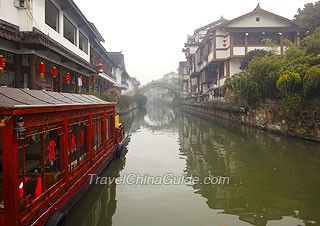China’s Grand Canal, Silk Road and South China Karst Listed as New World Heritage Sites
 |
China’s Grand Canal, symbolizing the diligence and wisdom of ancient Chinese people, is the longest existing artificial waterway in the world. The 1,200 mile (1,764 km) canal runs from Beijing to Hangzhou in southern China province Zhejiang. With a history of over 1,500 years since it was opened in the Sui Dynasty (581 - 618), the canal worked as a significant water transport of grain from southern cities to the capital in ancient times, as well as a source for irrigation for cities along the riverside. After it is listed as a world heritage site, more efforts will be done to protect the canal; public facilities and attractions along the canal will be still open to public and visitors.
 |
The 22 sites in China are listed below:
![]() Henan Province: The Ruins of Luoyang City during the Han and North Wei dynasties, Ruins of Dingding Gate of Luoyang City during the Sui and Tang dynasties, Ruins of Hangu Pass in Xin’an, Shihao Section of Xiaohan Ancient Path
Henan Province: The Ruins of Luoyang City during the Han and North Wei dynasties, Ruins of Dingding Gate of Luoyang City during the Sui and Tang dynasties, Ruins of Hangu Pass in Xin’an, Shihao Section of Xiaohan Ancient Path
![]() Shaanxi: Site of Weiyang Palace in Chang’an city of the Western Han Dynasty, Tomb of Zhangqian, Site of Daming Palace in Chang’an City of the Tang Dynasty, Big Wild Goose Pagoda, Small Wild Goose Pagoda, Xingjiao Temple Pagoda, Great Buddha in Binxian County
Shaanxi: Site of Weiyang Palace in Chang’an city of the Western Han Dynasty, Tomb of Zhangqian, Site of Daming Palace in Chang’an City of the Tang Dynasty, Big Wild Goose Pagoda, Small Wild Goose Pagoda, Xingjiao Temple Pagoda, Great Buddha in Binxian County
![]() Gansu: Ruins of Yumen Pass, Ruins of Xuanquanzhi, Maiji Caves, Bingling Temple Caves, Ruins of Suoyang City
Gansu: Ruins of Yumen Pass, Ruins of Xuanquanzhi, Maiji Caves, Bingling Temple Caves, Ruins of Suoyang City
![]() Xinjiang: Ruins of Gaochang City, Ruins of Jiaohe City, Kizilgaha Fire Beacon Tower, Kizil Grottoes, Subashi Ruins, Ruins of Beiting City
Xinjiang: Ruins of Gaochang City, Ruins of Jiaohe City, Kizilgaha Fire Beacon Tower, Kizil Grottoes, Subashi Ruins, Ruins of Beiting City
![]() According to the latest report from Doha, the World Heritage Committe added South China Karst (Phase II) into the world heritage list on Monday, June 23, 2014. The phase II, including the karst cluster in Guizhou, Chongqing, Guilin and Huanjiang in Guangxi Province, makes the list complete. Early in 2007, the South China Karst (Phase I), including Stone Forest in Yunnan, Libo Karst Cluster in Guizhou, and Wulong karst in Chongqing, was listed as world heritage site.
According to the latest report from Doha, the World Heritage Committe added South China Karst (Phase II) into the world heritage list on Monday, June 23, 2014. The phase II, including the karst cluster in Guizhou, Chongqing, Guilin and Huanjiang in Guangxi Province, makes the list complete. Early in 2007, the South China Karst (Phase I), including Stone Forest in Yunnan, Libo Karst Cluster in Guizhou, and Wulong karst in Chongqing, was listed as world heritage site.